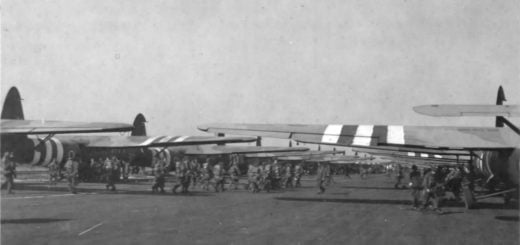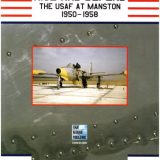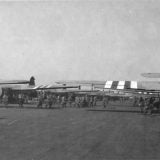Gotha raid of 22nd August 1917 – Part of the first “Battle of Britain”
Please note that this post is very much still in development. If you have any additions or corrections, please let us know.
During the First World War, the earlier raids by Zeppelin airships had brought the war to the civilian population on home soil. However, their impact was slight compared to the public anger at the Gotha bomber raids in 1917. The first of the raids was on 25th May 1917 and they would continue until 22nd August 1917.

On the morning of Wednesday 22nd August 1917, fifteen Gotha bombers of Kagohl 3 (England Squadron / England Geschwader) set out from their base near Ghent in Belgium, led by Hauptmann (Captain) Rudolf Kleine at around 0900 hrs. The plan was for a two-pronged attack; one to attack Sheerness then either Southend or Chatham; the other group to attack Dover. Mechanical problems forced four of the bombers to turn back while over the English Channel, then with the English Coast in sight, Kleine’s aircraft developed engine trouble as well and also had to turn back, leaving Oberleutnant Richard Walter, Staffelführer of Kasta 15, to lead the raid.


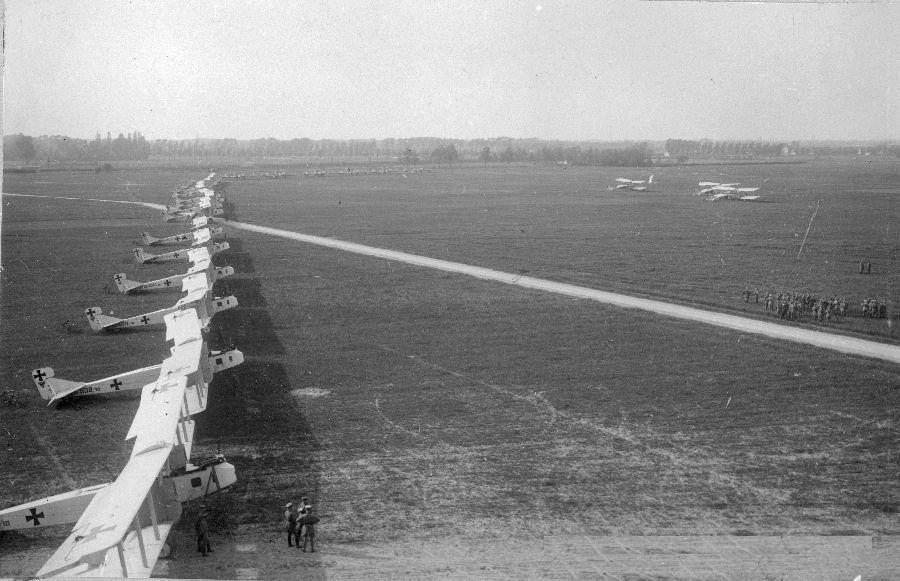
The V formation of enemy aircraft were heading towards North Foreland, but were reported at 1004 hrs from the Kentish Knock Light Vessel, giving plenty of advanced warning. Observers at the North Foreland Look Out Station heard the roar from the incoming engines and were observed flying ENE directly for the Foreland.

The alarm was raised both with airborne and land based units. Two miles out, anti-aircraft fire was put up by the land batteries and forced the enemy formation to break and turn North towards Margate where they arrived at 1026 hrs.
Just before reaching the English coast the leading aeroplane had to turn back on account of engine trouble. I took over command of the attack force, which still consisted of nine aeroplanes. The dropping out of the leading aeroplane created a momentary disquietude amongst the formation flying behind it as the red flares agreed upon produced only a trail of smoke. I then gave orders for star shells to be fired from the machine gun post. On reaching the English coast and flying inland I observed numbers of enemy AA defence aeroplanes, some of which were flying at a higher altitude than our attack force. In view of the strong wind, the well prepared AA defence and the small number of our aeroplanes, I considered that as it would anyhow be impossible to reach London, it would be inadvisable to proceed further inland. I therefore tried, by firing three star shells in quick succession, several times, to instruct the crews to raid objective No.3 (Dover). A raid on Dover, in view of the importance of this town to the battle proceeding in Flanders, would have been of the utmost importance. The crews failed to understand the signals and the bombs were dropped along the whole coastal area from Margate to Dover. Hits easily observed at Dover, Ramsgate and Margate.
Account by Obltn. Richard Walter, Staffelführer of Kasta 15

Flt Lt Arthur Frank Brandon of the Manston War Flight at RNAS Manston War School, in Sopwith Camel F.1 B3834 “Wonga Bonga” had already taken off at 0930 on a local patrol. He went up to 15,000 feet, but because he found it very cold, he decided to come back down. It was then that he saw a ground signal for “readiness”, knowing that aircraft were going to be scrambled. He climbed back to 15,000 feet and saw the rest of the flight climbing towards him. Wing Commander Robert Peel Ross had ordered the Manston War Flight of Flt. Sub-Lieutenant Edward Barfort Drake, Flight Sub-Lieutenant Cecil Henry Fitzherbert, Flt. Sub-Lieutenant Mark Adamson Harker and the Commanding Officer, Sqn Cdr Charles Henry Butler, into the air in their Sopwith Camels.
Elsewhere, three aircraft from Eastchurch, six from Walmer and two from Dover were ordered up in response to the attack.

Gotha G.IV of Kasta 16
Brandon decided to get between the enemy and the sun, and already had the advantage of height, being 2,000 feet above them. He targeted one of the twin-engined aircraft, a Gotha G.IV of Kasta 16 and dived towards it. He resisted the urge to fire until he was 200 feet away. He fired about 18 rounds before he saw the rear gunner slump. He circled and attacked a total of three times whilst the enemy aircraft directed fire towards him, firing over 600 rounds towards the Gotha. His gunfire struck the Gotha’s starboard engine, which burst into flames, then the Gotha broke into pieces as it plunged to earth. Some wreckage fell at the Hengrove Golf Course, at the time just off Shottendane Road, close to the AA battery there, and the rest in a field by Vincent Farm close to Manston. It was the first enemy aircraft to crash on English soil.
This aircraft is often referred to as Gotha G.IV 663/16, including by us, but we now believe that is the Gotha mentioned below.



All three of the German airmen, 22 year old pilot Unteroffizier Heinrich Schildt, observer Oberleutnant Eckhard Fulda and gunner Vizefeldwebel Ernst Eickelkamp were killed instantly.
The bodies were moved to the barn and after some civilians entered the barn and kicked the airmen, an armed guard was mounted. The crew were buried in St. John’s Cemetery in Margate a few days later on the 27th August 1917 with full military honours, attended by Wing Commander Ross. The service was carried out in the early light at 6am to prevent any demonstrations or problems from the civilian population, roused by the recent attacks on them. Their bodies were later moved to Cannock Chase War Cemetery.

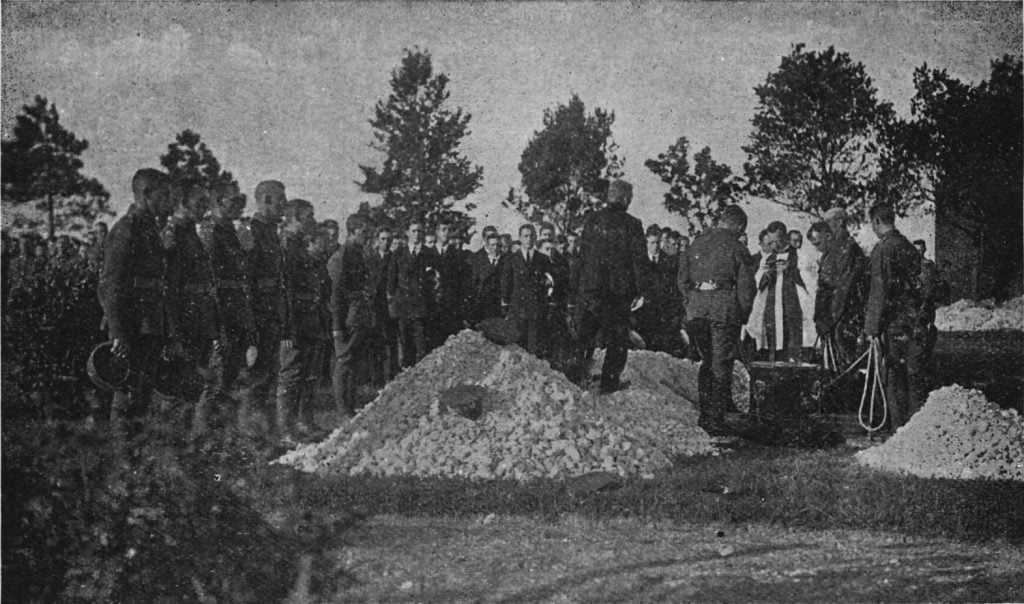
Shot down by AA gun fire. The aircraft nose dived, burst into flames and fell spinning like a top before crashing between Flete Farm and Vincent’s Farm at 10.36 a.m. One wing landed just outside Westgate seaplane station, another fell on allotments at the top of Bird’s Avenue, Garlinge, near Hengrove Golf Links, while the engines and the fuselage, with the remains of the crew, came to earth in a corn field at Flete Farm. The bodies were removed to a barn at nearby Vincent’s Farm, and although the pilot and observer were burnt beyond recognition, the gunner was still recognizable, his head and face being untouched. The crew was initially buried by the R.N.A.S. with full military honours in Margate Cemetery at daybreak on 27 August 1917.
Crash Information (from British sources)

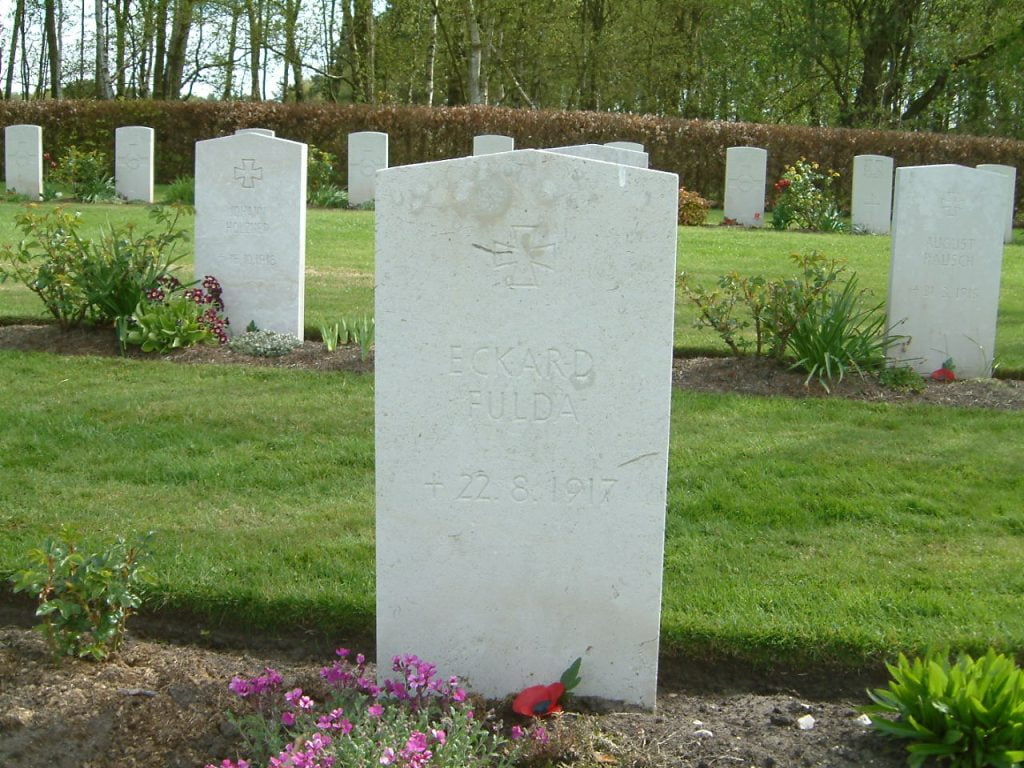


Even though luck seemed to have favoured Brandon given the amount of enemy gunfire towards him, his aircraft had been hit in its No.6 cylinder. He was forced to land, but reportedly after claiming his victory, he took off in another Camel, B3923 “Springbok” and set back off in pursuit of the formation over the North Sea until he ran out of ammunition. He fired around 300 rounds towards one aircraft that had split from the formation. “Springbok” had only been delivered to Manston ten days earlier. When he landed a neat bullet hole was found in one of his propeller blades. The aircraft must also have had further damage as three days later, it was considered bad enough to order it to be scrapped.

The coastal anti-aircraft guns fired at the Gothas throughout the raid.
The German Bombing Results
Five bombs landed in Margate. One wrecked an unoccupied house in Windsor Avenue and seriously damaged the neighbouring property, and two that landed in Approach Road smashed windows in about 60 properties in the vicinity. One unexploded bomb smashed through the roof of 42 Cliftonville Avenue and another landed on a potato plot near St. Mildred’s Road. There were no injuries in Margate. Almost immediately after coming inland, however, two Gothas were brought down, one by a defence aircraft and the other by AA fire. With dwindling numbers Kagohl 3 abandoned the attack on the Thames Estuary and turned for Dover, while more defence aircraft closed in and the guns continued to fire. One bomb fell on a field at Bromstone Farm, about half a mile outside Broadstairs while a falling AA shell injured a man in the town as the aircraft approached Ramsgate.
One bomb killed six men and a child sheltering in a store cut out of the chalk on Military Road by the harbour. Two schools serving as hospitals for the Canadian Army came under attack, with bombs causing damage in the grounds of Townley Castle and making a direct hit on Chatham House. There the bomb passed through the building before exploding in the basement where it killed a butcher. Other bombs narrowly missed St. Lawrence College (also serving as a Canadian Red Cross hospital), the Ramsgate County School, the Public Library and St. George’s Church where people were sheltering in the crypt. The bomb smashed stain glass windows and caused damage in neighbouring properties. Just a short distance away, in Church Hill, another bomb killed a Canadian soldier sheltering in the doorway of a newspaper office.
At the Town railway station a bomb damaged one of the platforms and a temporary canteen serving wounded soldiers on their way back from the Front, but no one was injured there. In Picton Road a bomb severely damaged six houses and injured three children, while in Prince’s Street near the harbour a bomb demolished three small cottages. Other bombs caused some damage in Boundary Road, Alexandra Road, Percy Road, Hollicondane Road, Duncan Road and St. Mildred’s Road. Of the 34 bombs dropped on Ramsgate seven failed to detonate. Casualties in Ramsgate amounted to nine killed and 22 injured.
The remaining eight Gothas went out to sea at Ramsgate and headed south down the coast towards Dover, engaged by AA guns and pursued by pilots of the RNAS. They came inland again at Deal and, approaching Dover from the north, dropped a bomb at Whitfield, which fell harmlessly in a field on Rosemount Farm. At 11.10am the Dover AA guns opened fire and two of the Gothas headed straight out to sea, leaving the other six to unload nine bombs on the town.
The first of these bombs exploded in the yard of the Admiral Harvey public house on Bridge Street where it killed 17-year-old Lucy Wall and caused serious damage. Another fell in Priory Hill but failed to explode, followed by one which did explode in the grounds of Dover College, where men of the 32nd Training Reserve battalion were under orders, killing two soldiers and injuring two. The bomb also injured an officer of the 30th Training Reserve battalion and an officer of the 3rd Battalion East Surrey Regiment (attached to the 32nd TR battalion). The bomb also caused significant damage to the College while another that fell by the College gateway failed to explode. Another bomb that failed to explode passed through 53 Folkestone Road, narrowly missing two of the occupants. At Dover Castle two bombs landed near the Keep where they killed a horse and seriously injured a soldier of the Royal Defence Corps, and two more fell in the harbour near to the RNAS seaplane station. But as the Gothas set course for home a third one was brought down in flames, its demise credited to RNAS pilot Flt sub-Lt E.B. Drake. Of the nine crew of the three Gothas brought down only one man survived.
From Zeppelins Over Britain



Gotha G.IV 663/16 of Kasta 15
Flight Commander Gerald Essex Hervey had taken off from Dover at 1020 hrs (0920 GMT) and arrived at North Foreland at 11,000 feet. He saw the Gothas coming inland. He climbed and engaged one, Gotha G/IV 663/16 of Kasta 15, on the right of the formation about 3 miles out to sea. He fired 100 rounds from straight behind his tail at 100 yards away. The aircraft started into a slow spin as his gun jammed which took several seconds to clear. He then followed the Gotha down and fired another 25 rounds into it. His gun jammed again, but while trying to clear it he got into a fast spin which he managed to get out of it to see the enemy aircraft crash in the sea, half a mile off Margate.
From: Flight Commr. G.E.Hervey
His Majesty's Aeroplane Station,
Dover
22nd August 1917
To: The Commanding Officer,
R.N. Aeroplane Station,
DOVER.
Submitted:-
I left at 9-20 G.M.T. and proceeded to North Foreland, when at 11000 feet I saw 10 Gothas coming inland. I climbed up to them and engaged one on the right of the formation about 3 miles out to sea off Margate at something over 12000 feet. Fired 100 rounds from straight behind his tail at 100 yards range. Tracers were seen going into the Huns fuselage. Machine started into a slow spin, my gun jambed and took several seconds to clear. I then followed Gotha down and fired about 25 more into him to make sure of him, my gun jambed again and in trying to clear it I got into a very fast spin with my engine on. I got out of this in time to see the Hun crash in the sea about half a mile off Margate. I then landed at Manstone, had my gun jamb cleared and then went up after their remaining 8 Gothas (one had been shot down in flames near Manstone). I caught up with them just off Dover at 14000 feet and engaged several of them in turn from both above and below. I then devoted all my attention to one Gotha and after I had fired over 200 rounds both his back guns were silenced. I think both Hun gunners must have been hit as I was able to get within 60 feet of him without being fired at. I finally ran out of ammunition and the Gothas went on apparently all right. I left the enemy about 15 miles of North Foreland. They were still being pursued by a number of our machines. During the time I was in contact with these German machines they were observed to use a signal like a Very's light, all white, and they were only seen singly. I am of the opinion that these machines must be armoured as from the last machine attacked he appeared full of bullets. Also I could not see the pilot at all, so that he must be well covered in. Their back guns fire extremely fast.
(Signed) G.E.Hervey
FLIGHT COMMANDER
From National Archives, possibly AIR 1/639/17/122/192
From (TBC):The Commanding Officer,
R.N.Aeroplane Station,
Dover.
To (TBC): The Senior Officer,
R.N.A.S.
Dover.
Submitted:-
Forwarded the above report of Fl.Commr.Hervey. I do not consider that this machine claimed could possibly be the same as that shot down by Flt.Lt.Kerby of Walmer as Fl.Commr.Hervey is positive that his machine did not catch fire while Fl.Lt.Kerby's apparently did. I consider this officer shewed great determination and good judgement in landing at Manstone to clear his gun and then again attacking. The other pilot, Fl.Sub.Lt.Bryan who went up to attack at the same time was forced to land almost immediately owing to a broken exhaust valve.
22.Aug.1917
Signed (unknown)
SQUADRON COMMANDER.
In Command.
From National Archives, possibly AIR 1/639/17/122/192
The Gotha’s pilot, 28 year old Leutnant D R Werner Joschkowitz and observer, 24 year old Leutnant Walter Latowsky were killed, but the 19 year old gunner Unteroffizier Bruno Schneider somehow survived and was taken as Prisoner of War after being picked up by HMS Kestrel. The wreckage was recovered, but apparently the bodies were not found at the time, however Leutnant Werner Joschkowitz was washed ashore near Den Helder on 27 September 1917; he was originally interred on 29 September 1917 at Den Helder, Netherlands and later re-interred at the Deutscher Soldatenfriedhof Ysselsteyn. Leutnant Walter Latowsky remains missing.
Shot down by AA gun fire. Crashed into the sea at 10.45 a.m. one mile off Cliftonville. According to the gunner the crew had intended to attack Dover. Near Ramsgate the AA fire was extremely accurate and put the starboard engine out of action. As a result the aircraft got into a spin from which it never recovered. After coming down in the sea the Gotha sank nose first and the gunner climbed up the fuselage and sat on the tail plane for about ten minutes before being rescued by ‘H.M.S. Kestral’. The wreckage was later recovered. On 27 September 1917 the body of a German aviator was washed ashore near Den Helder in the Netherlands. He was a Ltn., and on his underwear was found the initials J.W. The man was buried with full military honours in Den Helder on 29 September.
Crash Information (from British and Dutch sources)
Footage of Gotha GIV/663/16 shot down off Margate on 22nd August 1917 by Gerald Hervey. Watch from 0:02:12. Alternatively you can watch on the IWM site here: https://film.iwmcollections.org.uk/record/3072
Hervey landed at Manston to have his gun jam cleared and went back up after the remaining eight Gothas. He caught up with them just off Dover at 14,000 feet and initially engaged several of them in turn. He then concentrated on one and after firing over 200 rounds at it, the rear guns fell silent, presumably injuring or killing the gunners. He ran out of ammunition so left the aircraft being pursued by others. He was of the opinion that the aircraft must have been armoured and the pilot must have been protected, given the amount of bullets he fired at them.
Sopwith Scout (Pup) N.6438 of Flight Commander MacLaren also left from Dover, although usually based at Walmer. It had been under repair there and was being fetched at the time. After leaving at 1015 hrs, MacLaren found his gun would not fire, so he landed at Walmer to have it repaired. He then left at 1105 hrs and pursued the remaining seven aircraft ten miles out to sea but was unable to catch them. He returned after patrolling in the direction of the Kentish Knock Light Vessel.
Walmer Air Station
August 22nd, 1917
REPORT.
Pilot: Flt.Cmdr.C.T.MacLaren
Machine: Sopwith Scout N.6438.
Type of Hostile Machine: "Gotha"
When signal reporting H.A. was received I was at Dover fetching repaired machine, Sopwith Pup N 6348. Left Dover at 10.15 a.m. B.S.T., but gun would not fire a shot. Landed at Walmer and found that gun-shoot (sic) was displaced. Had this repaired and left again at 11.5 a.m. B.S.T. in pursuit of seven Gothas observed two miles north of Walmer at about 10,000 feet; chased these to Dover and 10 miles seawards but could make no impression on them so observing signal previously at Dover proceeded towards Kentish Knock Light Vessel, but nothing seen there. Returned and landed at 12.0 p.m. B.S.T. Did not observe any damage in neighbourhood of this Aerodrome.
(Signed) C.T. MacLaren
Flight Commander.
From National Archives, possibly AIR 1/639/17/122/192
Third Gotha
At Walmer the “Readiness” signal was received at 1020 hrs and Sopwith N.6440 of Flt Lt Kerby and Sopwith Scout N.6439 of Flt Sub Lt Kingsford took off at 1024 hrs. Kerby climbed to around 11,000 feet approaching Broadstairs. He was in the company of five Camels. The Gothas turned towards Stoner under heavy and accurate AA fire. Left behind by the Camels who outdistanced and outclimbed him, he observed two Camels attacking one of the leading Gothas which burst into flames. He and another Camel, presumably that of Flight Commander Hervey, were then in a good attacking position on the right-hand Gotha. He observed his tracer bullets going into the fuselage of the Gotha which almost immediately went into a steep spinning nose-dive. He followed it down with an occasional gun burst until it fell into the sea off Margate. It would appear that this was the same aircraft claimed by Hervey, although it would seem that Hervey was attempting to recover from his spin, so Kerby might have attacked in the meantime. With his engine oiled-up, he had to land on the beach at Margate. Kingsford was unable to climb as fast and did not engage the enemy aircraft.
Walmer Air Station
22nd August, 1917.
COMBAT REPORT.
Pilot: Flt.Sub-Lt. Kingsford
Machine: Sopwith Scout N.6439.
Type of Hostile Machine: "Gotha"
On receipt of hostile aircraft signal went off climbing in direction of Manston in company with Flight Lieut Kirby. Observed about ten Gotha machines. Flight Lieut Kirby was, I should think about 3,000 feet above me when I saw him attack a Gotha, and immediately afterwards it went down in a spinning nose-dive. I kept on climbing and proceeded to Dover when I saw A.A. fire and joined up with a flight of our machines, and turned back when they turned as Gothas were by that time out of sight.
(Signed) W.K.(?) Kingsford
Flight Sub-Lieutenant, R.N.
From National Archives, possibly AIR 1/639/17/122/192
Walmer Air Station
22nd August, 1917.
COMBAT REPORT.
Flight Lieut. Kerby reports:-
On receipt of hostile aircraft signal went off climbing in direction of Manston. Observed ten "Gotha" machines at about 11,000 feet approaching Broadstairs. In company with five "Camels" kept on climbing. Gothas now turned in direction of Stoner under heavy and very accurate A.A. Camels had now outdistanced and outclimbed me; observed two Camels attacking one of the leading Gothas, which immediately burst into flames. Another Camel and myself were now in a favourable position for attack on the right-hand Gotha. I closed and attacked from slightly below and on his quarter. Observed my "tracers" going into fuselage and Gotha practically at once went into a steep spinning nose-dive. I kept following it down getting in an occasional burst until Gotha finally fell into sea about quarter of a mile off the beach near Margate. My engine was oiled up and would not pick up and so I had to land on the beach at Margate.
(Signed) H.S. Kerby
Flight Lieutenant, R.N.
From National Archives, possibly AIR 1/639/17/122/192
Walmer Air Station
22nd August, 1917
Submitted:
Herewith report of action taken by Walmer Defence Flight against enemy aircraft on the morning of 22nd August.
The "Readiness" signal was received at 10.20 a.m and the following machines left the Aerodrome at 10.24 a.m. on sighting enemy aircraft off Broadstairs:
Sopwith N 6440, FLT.LT. KERBY;
Sopwith N 6439, FLT.SUB-LT. Kingsford.
Sopwith N 6438, FLT. COM. MacLaren left from Dover Aerodrome as it had been under repair there and was being fetched at the time.
Flt. Lt. Kerby climbed up to about 11,000 feet and engaged one of the ten Gothas over Broadstairs and sent the enemy aircraft down in a spin into the sea off Margate, a quarter of a mile from the shore (see Combat Report).
Flt. Sub-Lt. Kingsford was unable to climb so fast and so did not engage enemy aircraft (see Report).
On leaving Dover my gun would not fire so landed at Walmer, and had this repaired, the ammunition shoot (sic) having been knocked out of place. I then left again 11.5 a.m. in pursuit of seven Gotha machines and pursued them ten miles out to sea, but was unable to catch them up, so returned after patrolling in the direction of the Kentish Knock Light Vessel.
Flt. Lt. Little left at 10.35 a.m. in sopwith 9947, and engaged enemy aircraft over Dover, but had trouble with his gun and could only fire single shots. He pursued enemy aircraft across the Channel and landed at Aircraft Depot, Dunkirk (see Combat Report).
Your obedient servant,
(Signed) C.T. MacLaren
Flight Commander
From National Archives, possibly AIR 1/639/17/122/192

Flt Lt Little also left from Walmer in Sopwith Scout N.9947 at 1035 hrs and engaged enemy aircraft over Dover. Having trouble with his gun, he could only fire single shots. He pursued the enemy aircraft across the Channel and landed at Aircraft Depot, Dunkirk. He claimed that off Ostend he last saw the Gothas being attacked by five De Havilland 4s or possibly Bristol Fighters.
Walmer Air Station
August 22nd, 1917
REPORT
Pilot: Flt.Lt.Little.
Machine: Sopwith Scout N.9947.
Type of Hostile Machine: "Gotha"
Left Aerodrome in persuit of E.A. at 9.35. a.m. and chased 8 E.A. to Dover, when the last machine was attacked, but owing to the gun jamb the fight had to be broken off. Cleared jamb, but gun jambed again after ten rounds. Followed enemy aircraft out to sea and were last seen being attacked by five De Havilland 4's off Ostend.
(Signed) C.T. MacLaren
for F.Lt. Little
Flight Lieutenant, R.N.
From National Archives, possibly AIR 1/639/17/122/192
Having seen Brandon’s attack on the first Gotha, Sqn Cdr Butler led Drake, Fitzherbert and Harker inland to engage the Gothas. He attacked three at different times during the chase; Harker one at Dover; Fitzherbert attacked another at Ramsgate then a formation of three until they were well out to see and his ammunition exhausted. Flt Sub-Lt E B Drake in Camel B3844 made his first attack from 15,500 feet near Canterbury and concentrated a series of attacks on one target. Near to Dover, at 1120 hrs, the Gotha G.IV caught fire and fell.
This Gotha may have been piloted by Vizefeldw. Heinrich Putz, with Observer Lt.d.R. Hans Rolin and Gunner Unteroff Otto Rosinski.
Other Losses
The German’s claimed that Obltn. Mentzel, Ltn. Schiessler and Vzfw. Kerler of Kasta 17 shot down a British single-seater west of Deal. Ltn.d.Res. Alfred Schliessler received the Honour Cup for a victory in aerial combat. We do not as yet have confirmation or more details on this.
German reports also suggest that two Gothas failed to return with at least a third crashing on return. This aircraft may have been the Gotha G.IV of Kasta 15 which crashed near Ghent, Belgium, killing the pilot Vfw. Walter Brennecke (born Leipzig 8.9.1894), Observer & Staffelführer of 15/KG 3 Obltn. Walter Dachne (born Berlin 3.11.1890) and Gunner Gefreiter Max Dittmann (born Berlin 29.3.1895).
Vfw Brennecke is buried in Hooglede German Military Cemetery, Hooglede, Arrondissement Roeselare, West Flanders, Belgium.
Gefreiter Dittmann is buried in Vladslo German Military Cemetery, Vladslo, Arrondissement Diksmuide, West Flanders, Belgium.
We do not currently have information on the resting place of Obltn. Dachne.

However other reports suggest a total of four returning Gothas crashed on landing.
One of the crashes at Gontrode airfield was the Kasta 15 Gotha of pilot Unteroff. Kurt Delang, observer Lt. Paul Döge and gunner Vizefeldwebel Paul Ruhl who suffered a broken leg when he jumped out of the Gotha just before it touched down, afraid as he was that it would burn down.
The crash was due to the fact that during landing they were avoiding another plane and just some time before the real landing, completely ran out of fuel. This crew also claimed one plane, which seems to have been attacking them constantly from the east coast of England and which finally was hit, flames were bursting out of it, and it was leaving a trail of black smoke, until it finally plunged into the North Sea.
If the plane did actually plunge into the North Sea is another question however, two British planes did get into trouble. A Sopwith Camel B3798 from Eastchurch was shot up by a Gotha off Kent and was forced to land, while the pilot, Flight Comm. AF Bettington, was OK. Another Sopwith Camel was attacking a Gotha when his guns jammed and ended up being shot in the engine. N6333 from Manston, piloted by Flight Lt. AA Wallis possibly was the victim of the Döge crew.
Other crew members suggested as being lost on this day are:
- Unteroff. Otto Rosinsky, Kasta 16, gunner, KIA at Channel
- Unteroff. Stolle Rudi, Kasta 16, pilot, KIA at Gontrode
Disputes
Questions remain if the Gotha that Brandon claimed was shot down by him, or it was hit by ground fire. Sqn Cdr Butler saw Brandon’s guns firing and the rounds striking the Gotha which caught on fire, but his account is not universally accepted. Similarly, the Gotha that crashed into the sea off Margate is argued could have been taken down by the AA gunners instead of the aircraft from Dover. Some argue that Brandon had a share in the Gotha that crashed at sea and not the one at Vincent Farm. Seemingly it wasn’t just the airborne fighting that was in its infancy, but also the recognition and reporting. Indeed, it must have been harrowing enough for the British pilots to be fighting against the enemy aircraft, but worse given the reportedly constant barrage by ground guns.
The Legacy
The raid on 22nd August was the last daylight attack on England. The aircraft that made it back to Belgium bore many battle scars, including dead and wounded on board. The Gotha’s invulnerability had been proven wrong and the price of the raids was becoming too high.
These losses, against Britain’s improving defences, resulted in the Gothas of Kagohl 3 abandoning daylight raids and changing to night bombing.
For the British, the 13 week campaign was also costly, with nearly 20 tons of bombs being dropped on civilian targets, 401 dead and 983 injured. The resultant reports into the defences against what is often referred to as the first “Battle of Britain”, recommended the creation of an Air Ministry and a unified Air Service, which ultimately led to the formation of the Royal Air Force on 1st April 1918.
Wreckage from at least one of the Gothas was sold by auction for war charities at Margate Town Hall by the Mayor, Mr. W. B. Reeve.
A hero, lost
On 26th October 2017, Flt Lt Arthur Frank Brandon DSC RNAS in Sopwith Triplane N.5382 “Ooslumbird” collided with a Sopwith Pup N.6466 flown by Lt D.W. Gray. Flt Lt Brandon was killed and is buried in Minster Cemetery.
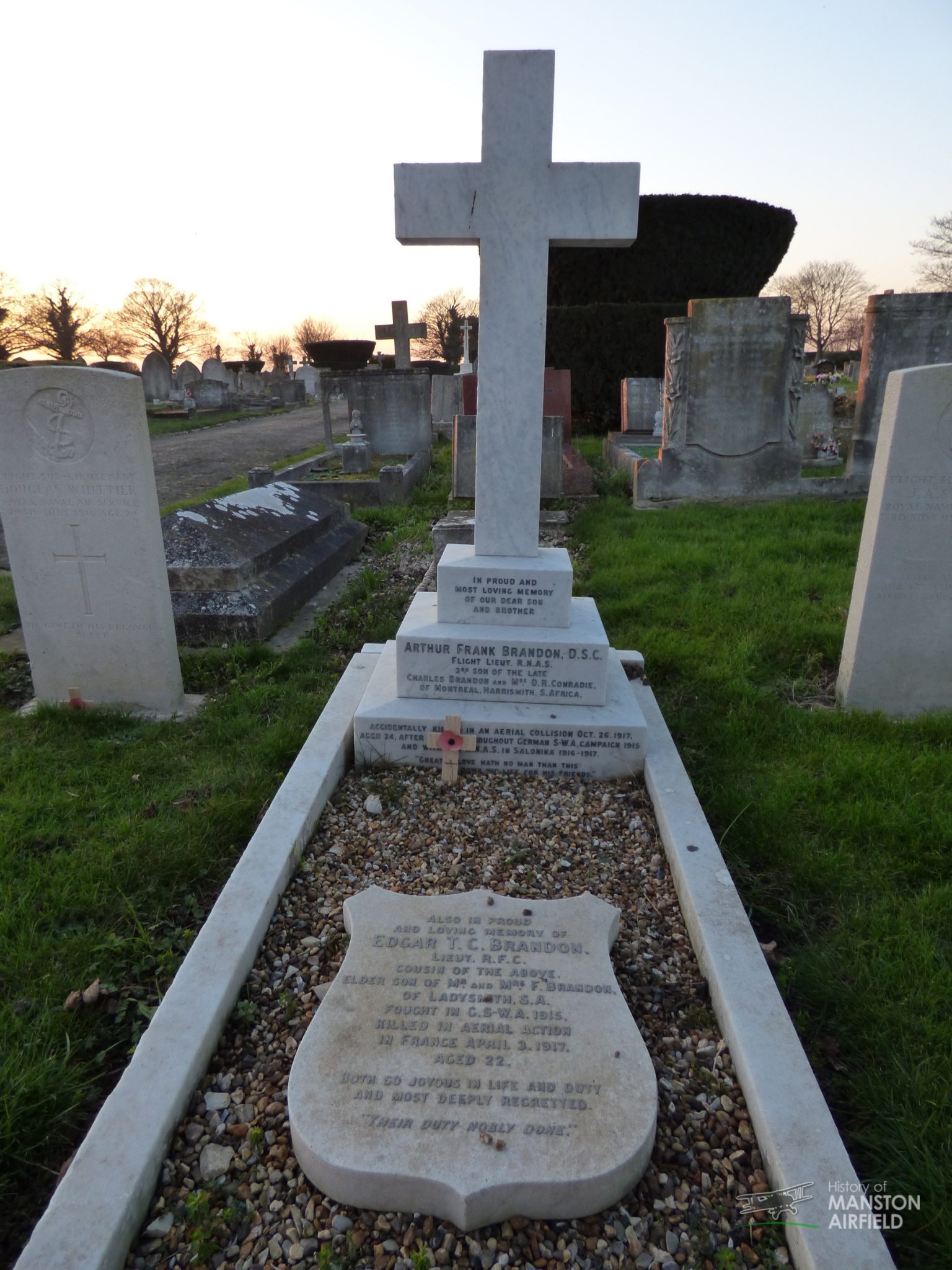
Arthur Frank Brandon was from Ladysmith, Natal, South Africa and fought against the Germans in South-West Africa before joining the RNAS. After service in Salonica, Brandon was invalided back to the UK in July 1917 but was flying again by the morning of 22 August 1917.
Awards
On 17th November 1917 it was announced that Brandon had posthumously been awarded the Distinguished Service Cross for his action on the 22nd August. Butler, Drake, Fitzherbert and Harker were “Mentioned in Despatches”.
On 18th October, notification was received that Flight Commander Hervey was to be awarded the Distinguished Service Cross, approved by the King.
18th October.
Vice Admiral Commanding,
DOVER PATROL.
With reference to your submission of the 26th August, No. 2740/048 J.R., forwarding a report from the Wing Captain, R.N.A.S., Dunkerque, on the distinguished services rendered by Flight Commander Gerald Essex Hervey, R.N.A.S., in destroying a Gotha aeroplane on the 22nd August, 1917, and also on other occasions, I am to acquaint you that the King has been pleased to approve of the award of the Distinguished Service Cross to Flight Commander Hervey in recognition of these services.
BY COMMAND OF THEIR LORDSHIPS,
Signed Walker.
From National Archives, possibly AIR 1/639/17/122/192
Sopwith Camel F.1 B3834 “Wonga Bonga”
“Wonga Bonga” was a 130hp Clerget 9B powered Sopwith F.1 Camel from a production order for 200 aircraft placed with The Sopwith Aviation Company Ltd in June 1917 (numbers B3751 to B3950). It was delivered to RNAS Manston War Flight on 10 July 1917 in response to the growing air raid panic caused by Gotha bombers and flew several Anti Gotha Patrols over the next two months piloted by RH Day and AF Brandon. The words “Wonga Bonga” (Wonga = Gotha, because of their distinctive engine sound, and Bonga = smasher). After 8 months of service, B3834 was scrapped in February 1918.
Footnote
If you have any reference material and would like to share with us, please let us know. We happily include accreditation as required and continue to be interested in material that may add or clarify information.
References:
- Awaiting update for details in “Wings over Westgate”, by Geoffrey Williams.
- The History of RAF Manston by Rocky Stockman.
- A Detailed History of RAF Manston 1916-1930 by Joe Bamford and John Williams.
- The North Foreland Lookout Post in the Great War 1915-1917.
- Pilot Log/Reports as detailed on the South East History Board: https://sussexhistoryforum.co.uk/index.php?topic=2956.0
- http://1914-1918.invisionzone.com/forums/index.php?/topic/214702-1917-gotha-airmen-killed-over-uk/
- http://1914-1918.invisionzone.com/forums/index.php?/topic/192630-trench-art-gotha-22-august-1917-margate/
- Zeppelins Over Britain
- https://www.theaerodrome.com/forum/showthread.php?t=49080
- Grave Marker photos by Forscher on Find a Grave.
- National Archives, possibly AIR 1/639/17/122/192
- http://www.airhistory.org.uk/rfc/Kagohl3-diary.html
- Strategic bombing: Gothas over London, by Ian Castle (Zeppelins Over Britain) https://www.military-history.org/feature/strategic-bombing-gothas-over-london.htm
First published: 22nd August 2017.
Last Updated: .



